Related Research Articles

A quasar is an extremely luminous active galactic nucleus (AGN). It is sometimes known as a quasi-stellar object, abbreviated QSO. The emission from an AGN is powered by a supermassive black hole with a mass ranging from millions to tens of billions of solar masses, surrounded by a gaseous accretion disc. Gas in the disc falling towards the black hole heats up and releases energy in the form of electromagnetic radiation. The radiant energy of quasars is enormous; the most powerful quasars have luminosities thousands of times greater than that of a galaxy such as the Milky Way. Quasars are usually categorized as a subclass of the more general category of AGN. The redshifts of quasars are of cosmological origin.
An active galactic nucleus (AGN) is a compact region at the center of a galaxy that emits a significant amount of energy across the electromagnetic spectrum, with characteristics indicating that this luminosity is not produced by the stars. Such excess, non-stellar emissions have been observed in the radio, microwave, infrared, optical, ultra-violet, X-ray and gamma ray wavebands. A galaxy hosting an AGN is called an active galaxy. The non-stellar radiation from an AGN is theorized to result from the accretion of matter by a supermassive black hole at the center of its host galaxy.
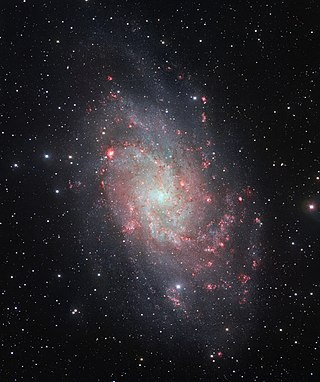
The Triangulum Galaxy is a spiral galaxy 2.73 million light-years (ly) from Earth in the constellation Triangulum. It is catalogued as Messier 33 or NGC (New General Catalogue) 598. With the D25 isophotal diameter of 18.74 kiloparsecs (61,100 light-years), the Triangulum Galaxy is the third-largest member of the Local Group of galaxies, behind the Andromeda Galaxy and the Milky Way.

Seyfert galaxies are one of the two largest groups of active galaxies, along with quasars. They have quasar-like nuclei with very high surface brightnesses whose spectra reveal strong, high-ionisation emission lines, but unlike quasars, their host galaxies are clearly detectable.

A supermassive black hole is the largest type of black hole, with its mass being on the order of hundreds of thousands, or millions to billions, of times the mass of the Sun (M☉). Black holes are a class of astronomical objects that have undergone gravitational collapse, leaving behind spheroidal regions of space from which nothing can escape, including light. Observational evidence indicates that almost every large galaxy has a supermassive black hole at its center. For example, the Milky Way galaxy has a supermassive black hole at its center, corresponding to the radio source Sagittarius A*. Accretion of interstellar gas onto supermassive black holes is the process responsible for powering active galactic nuclei (AGNs) and quasars.

An intermediate-mass black hole (IMBH) is a class of black hole with mass in the range 102–105 solar masses: significantly more than stellar black holes but less than the 105–109 solar mass supermassive black holes. Several IMBH candidate objects have been discovered in the Milky Way galaxy and others nearby, based on indirect gas cloud velocity and accretion disk spectra observations of various evidentiary strength.

A stellar black hole is a black hole formed by the gravitational collapse of a star. They have masses ranging from about 5 to several tens of solar masses. They are the remnants of supernova explosions, which may be observed as a type of gamma ray burst. These black holes are also referred to as collapsars.

Messier 32 is a dwarf "early-type" galaxy about 2,650,000 light-years (810,000 pc) from the Solar System, appearing in the constellation Andromeda. M32 is a satellite galaxy of the Andromeda Galaxy (M31) and was discovered by Guillaume Le Gentil in 1749.
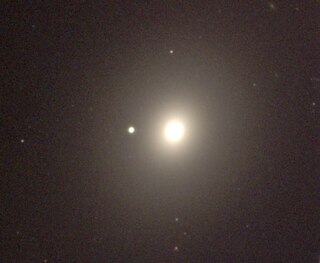
Messier 49 is a giant elliptical galaxy about 56 million light-years away in the equatorial constellation of Virgo. This galaxy was discovered by astronomer Charles Messier in 1777.

Messier 59 or M59, also known as NGC 4621, is an elliptical galaxy in the equatorial constellation of Virgo. It is a member of the Virgo Cluster, with the nearest fellow member 8′ away and around 5 magnitudes fainter. The nearest cluster member of comparable brightness is the lenticular galaxy NGC 4638, which is around 17′ away. It and the angularly nearby elliptical galaxy Messier 60 were both discovered by Johann Gottfried Koehler in April 1779 when observing comet seeming close by. Charles Messier listed both in the Messier Catalogue about three days after Koehler's discovery.
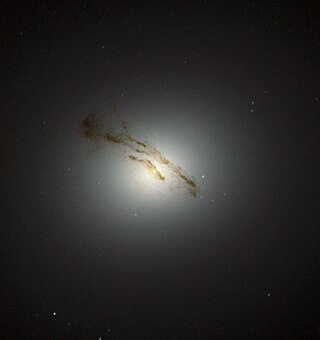
Messier 84 or M84, also known as NGC 4374, is a giant elliptical or lenticular galaxy in the constellation Virgo. Charles Messier discovered the object in 1781 in a systematic search for "nebulous objects" in the night sky. It is the 84th object in the Messier Catalogue and in the heavily populated core of the Virgo Cluster of galaxies, part of the local supercluster.
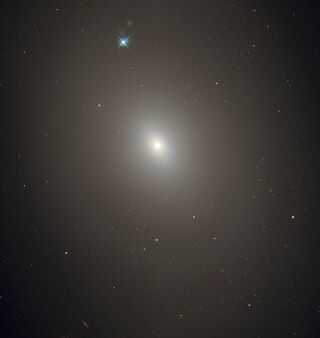
Messier 85 is a lenticular galaxy, or elliptical galaxy for other authors, in the Coma Berenices constellation. It is 60 million light-years away, and it is estimated to be 125,000 light-years across.

Messier 89 is an elliptical galaxy in the constellation Virgo. It was discovered by Charles Messier on March 18, 1781. M89 is a member of the Virgo Cluster of galaxies.
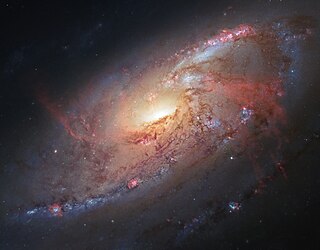
Messier 106 is an intermediate spiral galaxy in the constellation Canes Venatici. It was discovered by Pierre Méchain in 1781. M106 is at a distance of about 22 to 25 million light-years away from Earth. M106 contains an active nucleus classified as a Type 2 Seyfert, and the presence of a central supermassive black hole has been demonstrated from radio-wavelength observations of the rotation of a disk of molecular gas orbiting within the inner light-year around the black hole. NGC 4217 is a possible companion galaxy of Messier 106.

NGC 3384 is an elliptical galaxy in the constellation Leo. The galaxy was discovered by William Herschel in 1784 as part of the Herschel 400 Catalogue. The high age of the stars in the central region of NGC 3384 was confirmed after analysis of their color. More than 80% were found to be Population II stars which are over a billion years old. The supermassive black hole at the core has a mass of 1.6+0.1
−0.2×107 M☉.

A binary black hole (BBH), or black hole binary, is a system consisting of two black holes in close orbit around each other. Like black holes themselves, binary black holes are often divided into stellar binary black holes, formed either as remnants of high-mass binary star systems or by dynamic processes and mutual capture; and binary supermassive black holes, believed to be a result of galactic mergers.
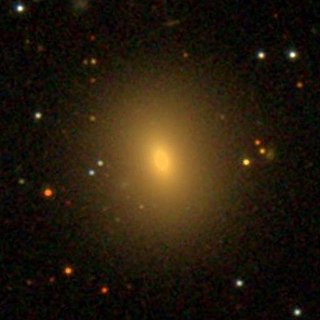
NGC 1270 is an elliptical galaxy located about 250 million light-years away in the constellation Perseus. It was discovered by astronomer Heinrich d'Arrest on February 14, 1863. NGC 1270 is a member of the Perseus Cluster and has an estimated age of about 11 billion years. However, Greene et al. puts the age of NGC 1270 at about 15.0 ± 0.50 Gy.

NGC 3585 is an elliptical or a lenticular galaxy located in the constellation Hydra. It is located at a distance of circa 60 million light-years from Earth, which, given its apparent dimensions, means that NGC 3585 is about 80,000 light years across. It was discovered by William Herschel on December 9, 1784.
References
- ↑ Shemmer, O.; Netzer, H.; Maiolino, R.; Oliva, E.; Croom, S.; Corbett, E.; di Fabrizio, L. (2004). "Near-infrared spectroscopy of high-redshift active galactic nuclei: I. A metallicity-accretion rate relationship". The Astrophysical Journal. 614 (2): 547–557. arXiv: astro-ph/0406559 . Bibcode:2004ApJ...614..547S. doi:10.1086/423607. S2CID 119010341.
- ↑ Klesman, Alison (29 June 2017). "Astronomers spot a pair of orbiting supermassive black holes". Astronomy Magazine.
- ↑ Ghisellini, Gabriele; Foschini, Luigi; Volonteri, Marta; Ghirlanda, Giancarlo; et al. (14 Jul 2009). "The blazar S5 0014+813: a real or apparent monster?". Monthly Notices of the Royal Astronomical Society. 399 (1): L24–L28. arXiv: 0906.0575 . Bibcode:2009MNRAS.399L..24G. doi:10.1111/j.1745-3933.2009.00716.x. S2CID 14438667. 17:53:24 GMT.
- ↑ Riechers, Dominik A.; Walter, Fabian; Carilli, Christopher L.; Lewis, Geraint F. (2009). "Imaging The Molecular Gas in a z = 3.9 Quasar Host Galaxy at 0."3 Resolution: A Central, Sub-Kiloparsec Scale Star Formation Reservoir in APM 08279+5255". The Astrophysical Journal. 690 (1): 463–485. arXiv: 0809.0754 . Bibcode:2009ApJ...690..463R. doi:10.1088/0004-637X/690/1/463. S2CID 13959993.
- ↑ Saturni, F. G.; Trevese, D.; Vagnetti, F.; Perna, M.; Dadina, M. (2016). "A multi-epoch spectroscopic study of the BAL quasar APM 08279+5255. II. Emission- and absorption-line variability time lags". Astronomy and Astrophysics . 587: A43. arXiv: 1512.03195 . Bibcode:2016A&A...587A..43S. doi:10.1051/0004-6361/201527152. S2CID 118548618.
- ↑ M87's satellite galaxy NGC 4486B, SEDS
- ↑ Romani, Roger W. (2006). "The Spectral Energy Distribution of the High-z Blazar Q0906+6930". The Astronomical Journal. 132 (5): 1959–1963. arXiv: astro-ph/0607581 . Bibcode:2006AJ....132.1959R. doi:10.1086/508216. S2CID 119331684.
- ↑ Nola Taylor Redd (March 5, 2014). "Monster Black Hole Spins at Half the Speed of Light". Space.com . Retrieved March 5, 2014.
- ↑ Sakano, Masaaki; Imanishi, Kensuke; Tsujimoto, Masahiro; Koyama, Katsuji; Maeda, Yoshitomo (1999). "Further Studies of 1E 1740.7−2942 with ASCA". The Astrophysical Journal. 520 (1): 316–323. arXiv: astro-ph/9903376 . Bibcode:1999ApJ...520..316S. doi: 10.1086/307441 . S2CID 17988034.
- ↑ Foellmi, Cédric (2009). "What is the closest black hole to the Sun?". New Astronomy. 14 (8): 674–691. arXiv: 0812.4232 . Bibcode:2009NewA...14..674F. doi:10.1016/j.newast.2009.04.003. S2CID 12843219.
- ↑ Burke, Mark J.; Raychaudhury, Somak; Kraft, Ralph P.; Brassington, Nicola J.; Hardcastle, Martin J.; Goodger, Joanna L.; Sivakoff, Gregory R.; Forman, William R.; Jones, Christine; Woodley, Kristin A.; Murray, Stephen S.; Kainulainen, Jouni; Birkinshaw, Mark; Croston, Judith H.; Evans, Daniel A.; Gilfanov, Marat; Jordán, Andrés; Sarazin, Craig L.; Voss, Rasmus; Worrall, Diana M.; Zhang, Zhongli (2012). "A Transient Sub-Eddington Black Hole X-Ray Binary Candidate in the Dust Lanes of Centaurus A". The Astrophysical Journal. 749 (2): 112. arXiv: 1202.3149 . Bibcode:2012ApJ...749..112B. doi:10.1088/0004-637X/749/2/112. S2CID 49949444.
- ↑ Kreidberg, Laura; Bailyn, Charles D.; Farr, Will M.; Kalogera, Vicky (2012). "Mass Measurements of Black Holes in X-ray Transients: is There a Mass Gap?". The Astrophysical Journal. 757 (36): 17pp. arXiv: 1205.1805 . Bibcode:2012ApJ...757...36K. doi:10.1088/0004-637x/757/1/36. S2CID 118452794.
- 1 2 Andrea Thompson (1 April 2008). "Smallest Black Hole Found". Space.com.
- ↑ Knapp, Alex (2012-02-22). "The Smallest Known Black Hole Has 20 Million Mile Per Hour Winds". Forbes. Retrieved 2012-02-22.
- ↑ NASA.gov, "NASA's RXTE Detects 'Heartbeat' of Smallest Black Hole Candidate", 2011.12.15 (accessed 2011.12.17)
- ↑ Liu, Jifeng; et al. (27 November 2019). "A wide star–black-hole binary system from radial-velocity measurements". Nature . 575 (7784): 618–621. arXiv: 1911.11989 . Bibcode:2019Natur.575..618L. doi:10.1038/s41586-019-1766-2. PMID 31776491. S2CID 208310287 . Retrieved 29 November 2019.
- ↑ Chinese Academy of Science (27 November 2019). "Chinese Academy of Sciences leads discovery of unpredicted stellar black hole". EurekAlert! . Retrieved 29 November 2019.
- ↑ ScienceDaily, "Heaviest Stellar Black Hole Discovered In Nearby Galaxy", Oct. 18, 2007 (accessed 12-12-2009)
- ↑ Kailash Sahu; et al. (Jan 31, 2022). "An Isolated Stellar-mass Black Hole Detected through Astrometric Microlensing". The Astrophysical Journal. 933 (1): 83. arXiv: 2201.13296 . Bibcode:2022ApJ...933...83S. doi: 10.3847/1538-4357/ac739e . S2CID 246430448.
- ↑ Lam, Casey Y.; Lu, Jessica R.; Udalski, Andrzej; Bond, Ian; Bennett, David P.; Skowron, Jan; Mroz, Przemek; Poleski, Radek; Sumi, Takahiro; Szymanski, Michal K.; Kozlowski, Szymon (2022-05-31). "An Isolated Mass-gap Black Hole or Neutron Star Detected with Astrometric Microlensing". The Astrophysical Journal Letters. 933 (1): L23. arXiv: 2202.01903 . Bibcode:2022ApJ...933L..23L. doi: 10.3847/2041-8213/ac7442 . S2CID 246608178.
- ↑ Gianopoulos, Andrea (2022-06-07). "Hubble Determines Mass of Isolated Black Hole Roaming Milky Way". NASA. Retrieved 2022-06-12.
- ↑ Gerke, Brian F.; Newman, Jeffrey A.; Lotz, Jennifer; Yan, Renbin; Barmby, P.; Coil, Alison L.; Conselice, Christopher J.; Ivison, R. J.; Lin, Lihwai; Koo, David C.; Nandra, Kirpal; Salim, Samir; Small, Todd; Weiner, Benjamin J.; Cooper, Michael C.; Davis, Marc; Faber, S. M.; Guhathakurta, Puragra; et al. (6 April 2007). "The DEEP2 Galaxy Redshift Survey: AEGIS Observations of a Dual AGN AT z p 0.7". The Astrophysical Journal Letters. 660 (1): L23–L26. arXiv: astro-ph/0608380 . Bibcode:2007ApJ...660L..23G. doi:10.1086/517968. S2CID 14320681.
- ↑ Valtonen, M. J.; Nilsson, K.; Sillanpää, A.; et al. (2006). "The 2005 November Outburst in OJ 287 and the Binary Black Hole Model". The Astrophysical Journal. 643 (1): L9–L12. Bibcode:2006ApJ...643L...9V. doi: 10.1086/505039 .
- ↑ Xaq Rzetelny (8 January 2015). "Supermassive black hole binary discovered".
- ↑ Matthew J. Graham; S. George Djorgovski; Daniel Stern; Eilat Glikman; Andrew J. Drake; Ashish A. Mahabal; et al. (25 July 2014). "A possible close supermassive black-hole binary in a quasar with optical periodicity". Nature. 518 (7537) (published 7 January 2015): 74–76. arXiv: 1501.01375 . Bibcode:2015Natur.518...74G. doi:10.1038/nature14143. ISSN 0028-0836. PMID 25561176. S2CID 4459433.
- ↑ ESA (25 April 2014). "Unique pair of hidden black holes discovered by XMM-Newton". Space Daily.
- 1 2 Deane, R. P.; Paragi, Z.; Jarvis, M. J.; Coriat, M.; Bernardi, G.; Fender, R. P.; et al. (24 June 2014). "A close-pair binary in a distant triple supermassive black hole system". Nature. 511 (7507) (published July 2014): 57–60. arXiv: 1406.6365 . Bibcode:2014Natur.511...57D. doi:10.1038/nature13454. PMID 24990745. S2CID 4461647.
- ↑ Schawinski, Kevin; Urry, Meg; Treister, Ezequiel; Simmons, Brooke; Natarajan, Priyamvada; Glikman, Eilat (29 November 2011). "Evidence for Three Accreting Black Holes in a Galaxy at z ~ 1.35: A Snapshot of Recently Formed Black Hole Seeds?". The Astrophysical Journal Letters. 743 (2) (published December 2011): 6. arXiv: 1111.6973 . Bibcode:2011ApJ...743L..37S. doi:10.1088/2041-8205/743/2/L37. S2CID 118497392. L37.
- ↑ Liu, Xin; Shen, Yue; Strauss, Michael A. (18 April 2011). "Cosmic Train Wreck by Massive Black Holes: Discovery of a Kiloparsec-scale Triple Active Galactic Nucleus". The Astrophysical Journal Letters. 736 (1) (published July 2011): L7–L11. arXiv: 1104.3391 . Bibcode:2011ApJ...736L...7L. doi:10.1088/2041-8205/736/1/L7. S2CID 118350891. L7.
